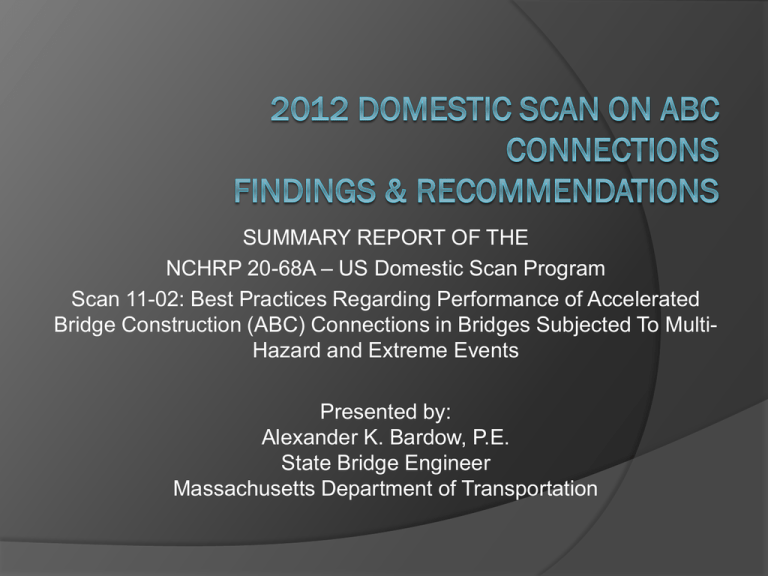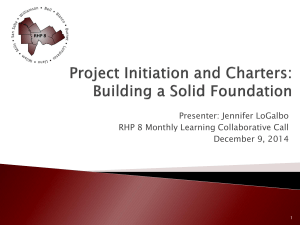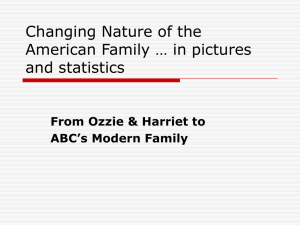Summary Report Presentation - Accelerated Bridge Construction
advertisement

SUMMARY REPORT OF THE NCHRP 20-68A – US Domestic Scan Program Scan 11-02: Best Practices Regarding Performance of Accelerated Bridge Construction (ABC) Connections in Bridges Subjected To MultiHazard and Extreme Events Presented by: Alexander K. Bardow, P.E. State Bridge Engineer Massachusetts Department of Transportation SPECIAL NOTE: The work described in this document was conducted as part of NCHRP Project 20-68A, the U.S. Domestic Scan program. This program was requested by the American Association of State Highway and Transportation Officials (AASHTO), with funding provided through the National Cooperative Highway Research Program (NCHRP). The NCHRP is supported by annual voluntary contributions from the state departments of transportation. Additional support for selected scans is provided by the U.S. Federal Highway Administration and other agencies. This report IS NOT an official report of the National Cooperative Highway Research Program, Transportation Research Board, National Research Council, or The National Academies. This report was prepared by the scan team for Scan 11-02 Best Practices Regarding Performance of Accelerated Bridge Construction (ABC) Connections in Bridges Subjected To Multi-Hazard and Extreme Events, whose members are listed herein. Scan planning and logistics are managed by Arora and Associates, P. C.; Harry Capers is the Principal Investigator. NCHRP Project 20-68A is guided by a technical project panel and managed by Andrew C. Lemer, Ph.D., NCHRP Senior Program Officer. Scan Team Members Scan Team Chair: Jugesh Kapur, PE, SE, Washington State DOT Scan Team Members: Alexander K. Bardow, PE, Mass DOT Waseem Dekelbab PhD, PE, TRB Michael Keever, Caltrans M. Saiid Saiidi*, PhD, PE, University of Nevada, Reno Joshua Sletten, SE, Utah DOT Dan Tobias, PhD, SE, Illinois DOT W. Phillip Yen, PhD, PE, FHWA *Subject Matter Expert preparing reports and presentations Objective Identify connection details that are used in the United States for ABC and which have performed well under extreme events, natural or man-made, such as waves and tidal action or storm-surges, seismic events, blast, and other large forces. Scan Team Events Several conference calls prior, in between, and subsequent to scans Desk Scan Organizational meeting: November 17, 2011 Desk Scan Objective Further the efforts of the full scan team in acquiring information of value to the transportation community. Increase the cost-effectiveness of a full scan by advising a team where best to commit its time during travel Help to refine the scope of the scan by identifying relevant sources of information around the country and narrowing the focus of the scan as needed. Desk Scan Tasks Summary review of the most relevant reports, papers, and web materials Collect and organize amplifying questions from scan team members Extensive survey of nine states with one or more extreme events and a known history of activities and interest in ABC Summarize desk scan findings in a report Recommend list of states and institutions to be visited or included in the scan through conference calls Organizational Meeting – Nov. 2011 Refined and finalized amplifying questions Finalized list of states and institutions to be visited or participate through conference calls Week 1: March 25-31, 2012 Visit Massachusetts* and Florida DOTs; Web conference participation by University of Buffalo and Texas and S. Carolina DOTs Week 2: April 22-28, 2012 Visit Utah, Washington*, and Nevada DOTs; Caltrans engineers/researchers participation while team meets in Nevada Visit University of Washington, Seattle, and University of Nevada, Reno, laboratories * Several bridge site visits in Massachusetts and Washington Scan Meeting Participants DOT Management Officials Engineers Contractors Fabricators Suppliers Researchers at selected institutions studying ABC connections under extreme events Summary of Amplifying Questions General Issues on Design for Multi-Hazard Loading ABC Design for Multi-Hazard Loading Decision and Design Tools for ABC Use Past ABC Application Partnership with Industry and Research Institutions ABC Inspection and Maintenance Summary of Initial Findings 8 Topic Areas: 1. Extreme load consideration for bridges and 2. 3. 4. 5. 6. 7. 8. ABC connections ABC connection details ABC connection maintenance Standardization of ABC connection details and processes ABC connection research Innovative ABC connections Monitoring ABC connections and prefabricated bridge elements and systems Other findings 1 - Extreme Load Consideration for Bridges and ABC Connections MH load combination considered only to a limited extent even in conventional bridges due to limited guidance and because of low probability of simultaneous occurrence No information specific to ABC connection design under MH loading Despite maturity of seismic design of conventional bridges, no AASHTO seismic design guidelines for ABC. Current AASHTO Guide restriction on splicing in SDC C and D– major hurdle on ABC use in high seismic zones 1 - Extreme Load Consideration for Bridges and ABC Connections (Cont’d) FHWA funded study to develop MH design guidelines for bridges in progress at U. of Buffalo - not specific to ABC. AASHTO LRFD framework is used as a platform to develop MH LRFD Examples of current MH load combination used in practice: Combined seismic and scour loads Wave action, wind, anchorage breakage, and vessel collision for floating bridge Advanced materials should allow for higher performance levels than conventional bridges under MH loading 2 - ABC Connection Details Many ABC connection types have been and continue to be developed Several states use FHWA-HIF-12-013 (Nov. 2011): Accelerated Bridge Construction Experience in Design, Fabrication and Erection of Prefabricated Bridge Elements and Systems. 2 - ABC Connection Details (Cont’d) Superstructure connection examples: Unrestrained joints under lateral loads Unrestrained joints under uplift due to storm surge Various concrete or grout mixes for closure pours for partial or full depth precast decks CIP concrete at closure pours between precast girders and at abutments. Continuous superstructure/approach slabs in SPMT moves or slides 2 - ABC Connection Details (Cont’d) Substructure connection examples : I. Precast column embedded into drilled shaft, footing, or cap beam 2 - ABC Connection Details (Cont’d) Substructure connection examples (Cont’d) : II. Grouted couplers embedded in precast column or in pile shaft, footing, or cap beam 2 - ABC Connection Details (Cont’d) Substructure connection examples (Cont’d) : III. Precast columns with extended bars inserted in grouted metal sleeves 3- ABC Connection Maintenance Insufficient history to make a call (if maintenance issues are different for ABC connections) General perception: should not be different if ABC connections are emulative (verified by a few ABC projects built in the 1990’s) In one state ABC projects are inspected annually to address any issues and develop performance data base 3 - ABC Connection Maintenance (Cont’d) Precautionary measures to avoid maintenance problems, e.g. “greased and sheathed” tendons, plastic ducts, posttensioning of deck panels, etc. Importance of grout quality, application, and consolidation is recognized. Deck slabs post tensioned together States are aware of the need for inspection and maintenance manuals when using unconventional materials and details. 4 - Standardization of ABC Connection Details and Processes Standard ABC connections: There is a strong push from stakeholders to standardize ABC connections Philosophical differences: well-defined details vs. versatile details Standard decision making process for selecting ABC over conventional construction Consistent application of user costs 4 - Standardization of ABC Connection Details and Processes (Cont’d) Examples of manuals for standard details: PCI – Northeast Several states utilizing FHWA 2011 ABC report Manuals for each precast element type Manuals for SPMT moves List of preapproved grouted couplers 4 - Standardization of ABC Connection Details and Processes (Cont’d) Standard decision making process for selecting ABC over conventional construction National effort: Oregon study Many states have or are developing their own process User costs are generally included and can help justify ABC Initial ABC cost may be higher because of financial risk to contractors; could become lower over time because of saving in durationdependent costs 5 - ABC Connection Research On-going studies on high-early strength concrete for closure pours Other ABC connection research focused on seismic performance Seismic studies may serve as a guide for other extreme load studies Two categories of seismic ABC connection research: emulative and non-emulative 5 - ABC Connection Research (Cont’d) Successful emulative ABC connections Precast columns embedded into footings, piles, or cap beams Large diameter column bars embedded in corrugated metal ducts Various standard couplers Various methods to convert multi-girder pier cap connections to integral pier caps Research continues 5 - ABC Connection Research (Cont’d) Successful non-emulative ABC connections Motivated by versatility of precast members Performance level exceeds conventional construction Post-tensioned segmental columns 5 - ABC Connection Research (Cont’d) Successful non-emulative ABC connections (Cont’d) Energy dissipation with advanced materials and details: e.g. shape memory alloys, HPC, built-in rubber, FRP wrapping, and concrete-filled steel and FRP tubes Research continues FRP Wrap Conc.-Filled FRP Tube Built-in Rubber 6 - Innovative ABC Connections ABC is innovation in CONSTRUCTION Other innovation possible through ABC Innovative precast double-T precast girders Folded plate girders Concrete-filled tube arches Post-tensioned bridge decks, abutments, cap beams Base isolation to simplify ABC connections FHWA-HFL good mechanism to bring innovation to practice 7- Monitoring ABC Connections and Prefabricated Bridge Elements Done on a selected basis for nonemulative connections May not be necessary for emulative ABC connections Short-term monitoring common in SPMT moves Frequent (annual, in addition to NBIS biennial) inspection of ABC bridges 8 - Other Findings High enthusiasm and interest in ABC Key to success in ABC: COMMUNICATION among top management, designers, contractors, fabricators, industry and public Early involvement of contractors and fabricators in design and planning - design-build projects provide such an opportunity Site casting has to be used when precast plants are remote Shift of role: from CONSTRUCTION to INSTALLATION - contractors need to be open 8 - Other Findings (Cont’d) Education and training needed for ABC connection design and inspection ABC design manuals are being integrated into state bridge design manuals Documenting ABC lessons is essential. Examples: Convert circular columns to octagonal shape to cast on the side Avoid multi-segment columns unless necessary Transport issues of short heavy segment (load has to be spread over many axles) Recommendations Continue research into MH load combinations and ABC connections. Initiate NCHRP project to synthesize this research, fill knowledge gaps and develop design procedures for AASHTO LRFD. Establish a full time national center on ABC under MH as a central resource for collecting on-going research, detailing, construction and ABC performance both long term and after MH Build on FHWA Everyday Counts vision to reach out to AGC, decision makers, and others to promote ABC Recommendations (Cont’d) Expand demonstration ABC projects through the FHWA IBRD program in areas with extreme event loads Continue research on emulative ABC connections to facilitate ABC use in areas of high seismicity and other extreme events Continue and expand research on ABC connections with advanced materials and details under MH loading Collect and interpret field data of ABC connection performance. Explore integration of effort with FHWA LTBP Implementation Actions Seminars and webinars at venues attended by bridge engineers, contractors, suppliers, fabricators, etc., such as AASHTO SCOBS, TRB Annual Meeting and TRB conferences, and websites (FHWA, NCHRP 2068, Florida IU ABC site) Identify champions in relevant AASHTO Technical Committees and follow up on implementation of recommendations Form an ABC user group to bring together various stakeholders Express support for current FHWA MH loading studies to FHWA management Implementation Actions (Cont’d) Problem statement to develop Performance Based Design guidelines of emulative and non-emulative ABC connections Garner support for a national center on ABC under MH loading Technical articles summarizing the scan findings for publication in the TRB TR News and other industry journals Coordinate with FHWA and others to help implement the scan recommendations






